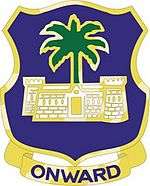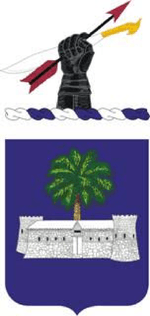25th Infantry Regiment (United States)
| 25th Infantry Regiment | |
|---|---|
|
Coat of arms of the 25th Infantry Regiment | |
| Active | 1866–1946 |
| Country |
|
| Branch |
|
| Type | Infantry |
| Size | Regiment |
| Engagements |
Indian Wars Spanish–American War Philippine–American War World War II |
| Insignia | |
| Distinctive unit insignia |
 |
| U.S. Infantry Regiments | |
|---|---|
| Previous | Next |
| 24th Infantry Regiment | 26th Infantry Regiment |
The Twenty-fifth United States Infantry Regiment was one of the racially segregated units of the United States Army known as Buffalo Soldiers. The 25th served from 1866 to 1946, seeing action in the American Indian Wars, Spanish–American War, Philippine–American War and World War II.
Other units known as "25th Infantry Regiment"
There was a 25th Infantry Regiment, raised in 1812, that served on the Lake Champlain front and the Niagara Frontier in the War of 1812. In 1815, during a postwar reduction in force, it was consolidated with four other regiments to form the 6th Infantry Regiment.[1]
On 28 July 1866 the 2nd Battalion, 18th Infantry, raised in 1861 for service in the American Civil War, was separated and designated the 25th Infantry Regiment. In 1869, it was consolidated back into the 18th.[2]
History

After the Civil War, the regular army was expanded to 45 infantry regiments from its wartime strength of 19. The act of Congress that authorized this included the creation of four regiments of "Colored Troops", racially segregated units with white officers and African-American enlisted men. The army had raised a number of volunteer United States Colored Troops (USCT) regiments during the war. The new regiments were the 38th, 39th, 40th and 41st Infantry Regiments, and they set about recruiting mostly from USCT veterans.
By an act of 3 March 1869, Congress reduced the 45 regiments to 25, and the four colored regiments to two. The 39th and 40th Regiments were consolidated and renumbered as the 25th Infantry Regiment. In April the 25th established its first headquarters at Jackson Barracks, Louisiana, under command of Colonel Joseph A. Mower.[3]
Indian Wars
In May 1870 the regiment was ordered to San Antonio, Texas. After a short period there, its companies were distributed across a number of small west Texas posts, including Forts Bliss, Clark, Davis, and Stockton.[3] The 25th was posted along the Mexican border in Texas and New Mexico for the next ten years, providing border security, building roads and telegraph lines, and on occasion participating in operations against Indian bands.[3] In 1878, a detachment entered Mexico on a punitive expedition.
In 1880 the 25th was transferred to the northern Great Plains, operating mostly in Dakota Territory, Montana and Minnesota. Elements of the 25th took part in the last major Indian campaign, the Pine Ridge Campaign of 1890–91.[3]
Several companies of the 25th were deployed to break the Northern Pacific Railroad strike of 1894.
In 1896 Lieutenant James A. Moss formed a volunteer corps of bicycle troops to study the effectiveness of the concept, especially in the mountainous terrain of the Rockies. Eight soldiers and Moss made practice runs to Glacier and the Yellowstone National Park in the summer of 1896. In 1897, Moss, a surgeon, a reporter and 20 enlisted men made a 41-day, 1,900-mile ride from Fort Missoula, Montana to St. Louis, Missouri.[4]
Spanish–American War
All four colored regiments were transferred to Florida in the spring of 1898 in preparation for the war with Spain. They were assigned to Major General William R. Shafter's V Corps, which moved to Cuba to capture the major eastern city, Santiago de Cuba.[5]
The 25th participated in the 1 July 1898 assault on El Caney, commanded by Brigadier General Henry W. Lawton. Men from the 25th were among the first to reach the summit. Private T.C. Butler of H Company was first into the blockhouse at the summit, capturing the Spanish flag. An officer of the 12th Infantry ordered Butler to turn over the flag, and the 12th later claimed credit for the capture. Lieutenant Colonel A. S. Daggett, commanding the 25th, filed an official protest over the incident.[5][6]
On 14 July, when the Spanish surrendered the city, the 25th had advanced closer to Santiago than any other unit.[6]
Philippine–American War
In 1899 the 25th returned from Cuba to posts in the southern Rockies. Late in the year they shipped out to the Philippine Islands to participate in operations against the Philippine nationalist movement of Emilio Aguinaldo. They returned to the U.S. in 1902.[3]
Brownsville Affair
In 1906 a company of the 25th Infantry was dishonorably discharged without a trial on grounds of having shot at whites in Brownsville, Texas.
In 1972 the accused were found to be innocent of the charges and the 1906 order was reversed.
The Forest Fires of 1910
In the summer of 1910, the newly created United States Forest Service was fighting hundreds of fires across northern Idaho, Western Montana and eastern Washington. Drought conditions, high winds, high temperatures and lightning had created hundreds of forest fires. Dispatched by the Army to assist in the firefighting efforts, members of Company G, 25th Infantry Regiment, stationed at Fort George Wright in Spokane, Washington were sent to Avery, Idaho. Arriving on 17 August 1910, the soldiers worked on the fire threatening the town over the next four days. On 21 August the forest fire, pushed by strong winds and joining other fires, forced the evacuation of Avery, and the Soldiers of the 25th Infantry Regiment were instrumental in the safe evacuation of hundreds of townsfolk. By the time the fire ended a few days later, over three million acres had been burned. After the fire the soldiers assisted with the cleanup and in the search and recovery of the many that were killed during the fire.[7][8]
In the PBS documentary titled "The Big Burn", historians credit the Buffalo Soldiers with saving the town of Avery by building a "back" fire that collided and then consumed the "front" fire until there was no fire. Their "wit" saved the town from utter destruction.
World War I
During World War I, the 25th was assigned to garrison duty in Hawaii and did not see combat.[9]
World War II
In World War II the 25th Infantry Regiment (Colored) was an organic component of the 93rd Infantry Division (Colored) and served in the Pacific Theater of Operations. The regiment departed San Francisco on 24 January 1944 and arrived on Guadalcanal in echelons between 7 February and 5 March 1944. From there the regiment was transferred to Bougainville and attached to the Americal Division to take part in offensive operations against Japanese forces on that island in April and May of the same year. From 26 May to 21 June the regiment was stationed on the Green Islands where it received further training and was employed for the construction of defensive fortifications and installations. From 10 November 1944 to 30 March 1945 the 25th Infantry Regiment was involved in defensive actions around Finschafen New Guinea. The regiment's final transfer during World War II was to Morotai Island where it arrived by 12 April 1945 where it once again participated in offensive operations until the end of the war. For World War II the 25th Infantry Regiment (Colored) received campaign credit for the Northern Solomons, Bismarck Archipelago and New Guinea. The regiment was inactivated at Camp Stoneman, California on 3 February 1946, and within a few years, the entire U.S. military was ordered desegregated by President Harry Truman, ending all segregation in the American armed forces.
Campaigns
Notable soldiers and officers
- Prince Romerson (c. 1840–1872), a Native Hawaiian soldier from the Kingdom of Hawaii who also fought in the Civil War.[10]
- Carroll Augustine Devol (1859–1930), quartermaster.[11]
- Gilbert W. Lindsay (1900–1990), Los Angeles City Council member, 1963–1990.
- James Ray Beauregard (1972–1994).
Notes
- ↑ "Unit Lineage and Honors Information, section "6th Infantry"". United States Army Center of Military History.
- ↑ ""Unit Lineage and Honors Information", section "18th Infantry"". United States Army Center of Military History.
- 1 2 3 4 5 Fort Davis NHS
- ↑ Coffman, The Old Army, p.357
Hosler, Lieutenant Colonel Roderick A. (2 January 2011). "Hell on Two Wheels: The 25th Infantry Bicycle Corps". armyhistoryjournal.com. The Army Historical Foundation. Retrieved 21 September 2014. - 1 2 Schubert, "Buffalo Soldiers at San Juan Hill"
- 1 2 Pullen memoir
- ↑ Egan, Timothy (2009). The big burn:Teddy Roosevelt and the fire that saved America. New York: Houghton Mifflin Harcourt.
- ↑ Lewis, Edson E. (7 September 1910), Report of the Commanding Officer of G Company, 25th Infantry Regiment in Fletcher, Marvin (Summer 1972). "Army Fire Fighters" (PDF). Idaho Yesterdays: 12–15. Retrieved 16 July 2014.
- ↑ McNeil, William (2007). Black Baseball Out of Season. Jefferson, N.C.: McFarland. p. 52.
- ↑ McCunn, Ruthanne Lum (2015). "Prince Romerson". In Shively, Carol A. Asians and Pacific Islanders and the Civil War. Washington, D. C.: National Park Service. pp. 142–145. ISBN 978-1-59091-167-9. OCLC 904731668.
- ↑ "Major General Devol Ends Life With Gun. Retired Army Officer Had Been Ill for Several Months in California Home". New York Times. 4 June 1930. Retrieved 2015-04-11.
References
 This article incorporates public domain material from websites or documents of the United States Army Center of Military History.
This article incorporates public domain material from websites or documents of the United States Army Center of Military History.
- Coffman, Edward M. (1988). The Old Army:A Portrait of the American Army in Peactime, 1784–1898. Oxford University Press, New York. ISBN 0-19-504555-6.
- Nankiwell, John H. Buffalo Soldier Regiment: History of the Twenty-Fifth United States Infantry. ISBN 0-8032-8379-2.
- Pullen, Frank W., Jr. (1899-03-23). ""A Perfect Hailstorm of Bullets": A Black Sergeant Remembers the Battle of San Juan Hill in 1899". History Matters: The U.S. Survey Course on the Web. Retrieved 2008-10-29.
- Schubert, Frank N. (1998). "Buffalo Soldiers at San Juan Hill". United States Army Center of Military History. Archived from the original on 23 October 2008. Retrieved 2008-10-28.
- Egan, Timothy, (2009). – The Big Burn: Teddy Roosevelt and the Fire That Saved America – Houghton Mifflin Harcourt – ISBN 0-618-96841-5.
- Stanton, Shelby S. (1991). World War II Order of Battle. Galahad Books, New York. ISBN 0-88365-775-9.
- "Unit Lineage and Honors Information". United States Army Center of Military History. Archived from the original on 8 December 2008. Retrieved 2008-10-28.
- "25th U.S. INFANTRY AT FORT DAVIS, TEXAS". Fort Davis National Historic Site, Fort Davis, Texas. Retrieved 2008-10-29.
External links
- 25th Infantry Regiment (Buffalo Soldiers) US Army
- U.S. Army regimental history for the 25th part of Army of the United States
- 1907 Senate report on Brownsville Affair
- Theophilus Gould Steward, A Charleston Love Story from American Studies at the University of Virginia
- ENGAGEMENTS by the BUFFALO SOLDIERS AND SEMINOLE-NEGRO INDIAN SCOUTS

_troops_return_colors_to_Union_League_Club._Men_draw_._._._-_NARA_-_533590.tif.jpg)